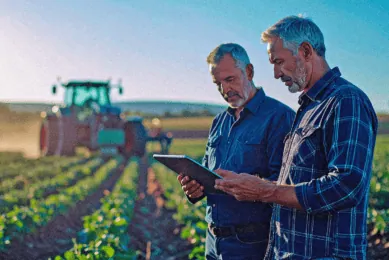Rapid adoption of artificial intelligence in agriculture

The AI in agriculture market was valued at USD 600 million in 2018 and is expected to reach USD 2.6 billion by 2025.
Agriculture is seeing rapid adoption of Artificial Intelligence (AI) and Machine Learning (ML), both in terms of agricultural products and in-field farming techniques.
According to research company MarketsandMarkets, the AI in agriculture market was valued at USD 600 million in 2018 and is expected to reach USD 2.6 billion by 2025, at a CAGR of 22.5% during the forecast period.
Computing the most disruptive technology
The report states that cognitive computing in particular is all set to become the most disruptive technology in agriculture services as it can understand, learn, and respond to different situations (based on learning) to increase efficiency.
The major factors driving the growth of the AI in agriculture market include:
- the growing demand for agricultural production owing to the increasing population
- rising adoption of information management systems and new advanced technologies for improving crop productivity
- increasing crop productivity by implementing deep learning techniques
- growing initiatives by worldwide governments supporting the adoption of modern agricultural techniques.
According to Apurva Agarwal, Associate Director, Electronics and Semiconductor, MarketsandMarkets “The combination of the Internet of Things (IoT) and artificial intelligence technologies, such as machine learning, computer vision, and predictive analytics, allow farmers to analyse real-time data of weather conditions, temperature, soil moisture, plant health, and crop prices in real time.”
Transforming weather forecast with AI
Weather tracking and forecasting are important applications of AI in agriculture as it facilitates gathering up-to-date information of prevailing weather conditions such as temperature, rain, wind speed and direction, and solar radiation. According to a research study, 90% of crop losses are due to weather events and 25% of these losses could be prevented by using predictive weather modelling.
Text continues underneath image
Various kinds of devices including handheld instruments, sensors, GPS and on-field weather stations are used for the application of weather tracking to get real-time information. The availability of real-time information helps farmers in making various decisions such as timely sowing of crops, weed detection, and pre-harvesting analysis of crops. The market for weather tracking and forecasting application is expected to grow at the highest CAGR of 25% during the forecast period.
North America to dominate the AI in agriculture market
According to Rahul Kumar, Senior Research Analyst, Electronics and Semiconductor, MarketsandMarkets “North America is expected to account for a major share of the AI in agriculture market by 2025, while the market in APAC is expected to grow at the highest CAGR during the forecast period.”
The presence of several agriculture technology providers such as IBM, Microsoft, John Deere, Granular, Blue River Technology, and The Climate Corporation in this region is driving the growth of the North American AI in agriculture market. The AI in agriculture market in Asia Pacific is estimated to grow at a high CAGR during the forecast period. The increasing adoption of deep learning and computer vision technologies for agricultural applications is the major factor driving the growth of AI in agriculture market in APAC region.
Key players
The key players operating in the AI in agriculture market are IBM (US), John Deere (US), Microsoft (US), Agribotix (US), The Climate Corporation (US), ec2ce (Spain), Descartes Labs (US), Sky Squirrel Technologies (Canada), Mavrx (US), aWhere (US), Gamaya (Switzerland), Precision Hawk (US), Granular (US), Prospera (Israel), Cainthus (US), Spensa Technologies (US), Resson (Canada), FarmBot (US), Connecterra (Netherlands), Vision Robotics (US), Harvest Croo (US), Trace Genomics (US), Vine Rangers (France), and CropX (Israel).
Major players in this market have adopted strategies such as acquisitions, and partnerships, for the growth of the overall artificial intelligence in agriculture market. For instance, in September 2017, Deere & Company acquired Blue River Technology (US), an artificial intelligence (AI) start-up. Blue River Technology uses AI to identify and spray herbicides on weeds. Similarly, in March 2017, the climate corporation partnered with TerrAvion (Israel) to deliver high-resolution imagery to farmers.
Also read: Artificial intelligence to replace farmer’s knowledge?
Join 17,000+ subscribers
Subscribe to our newsletter to stay updated about all the need-to-know content in the agricultural sector, two times a week.



